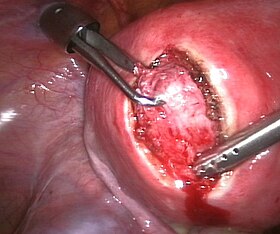Uterine myomectomy
| Uterine myomectomy | |
|---|---|
| Intervention | |

A laparoscopic myomectomy: The uterus has been incised and the myoma is held and about to be shelled out
|
|
| ICD-9-CM | 68.29 |
Myomectomy, sometimes also fibroidectomy, refers to the surgical removal of uterine leiomyomas, also known as fibroids. In contrast to a hysterectomy the uterus remains preserved and the woman retains her reproductive potential.
The presence of a fibroid does not mean that it needs to be removed. Removal is necessary when the fibroid causes pain or pressure, abnormal bleeding, or interferes with reproduction. The fibroids needed to be removed are typically large in size, or growing at certain locations such as bulging into the endometrial cavity causing significant cavity distortion.
Patients have many options in the management of uterine fibroids, including: observation, medical therapy (such a GNRH agonists), hysterectomy, uterine artery embolization, and high-intensity focused ultrasound ablation. Despite these many options, the surgical approach of selected fibroid removal remains an important choice for those women who want or need to preserve the uterus.
A myomectomy can be performed in a number of ways, depending on the location and number of lesions and the experience and preference of the surgeon. Either a general or a spinal anesthesia is administered.
Traditionally a myomectomy is performed via a laparotomy with a full abdominal incision, either vertically or horizontally. Once the peritoneal cavity is opened, the uterus is incised, and the lesion(s) removed. The open approach is often preferred for larger lesions. One or more incisions may be set into the uterine muscle and are repaired once the fibroid has been removed. Recovery after surgery takes six to eight weeks.
Using the laparoscopic approach the uterus is visualized and its fibroids located and removed. Morcellators are available to shred larger fibroids so that they can be removed through the small portholes of laparoscopy. Studies have suggested that laparoscopic myomectomy leads to lower morbidity rates and faster recovery than does laparotomic myomectomy. As with hysteroscopic myomectomy, laparoscopic myomectomy is not generally used on very large fibroids. A study of laparoscopic myomectomies conducted between January 1990 and October 1998 examined 106 cases of laparoscopic myomectomy, in which the fibroids were intramural or subserous and ranged in size from 3 to 10 cm.
...
Wikipedia
